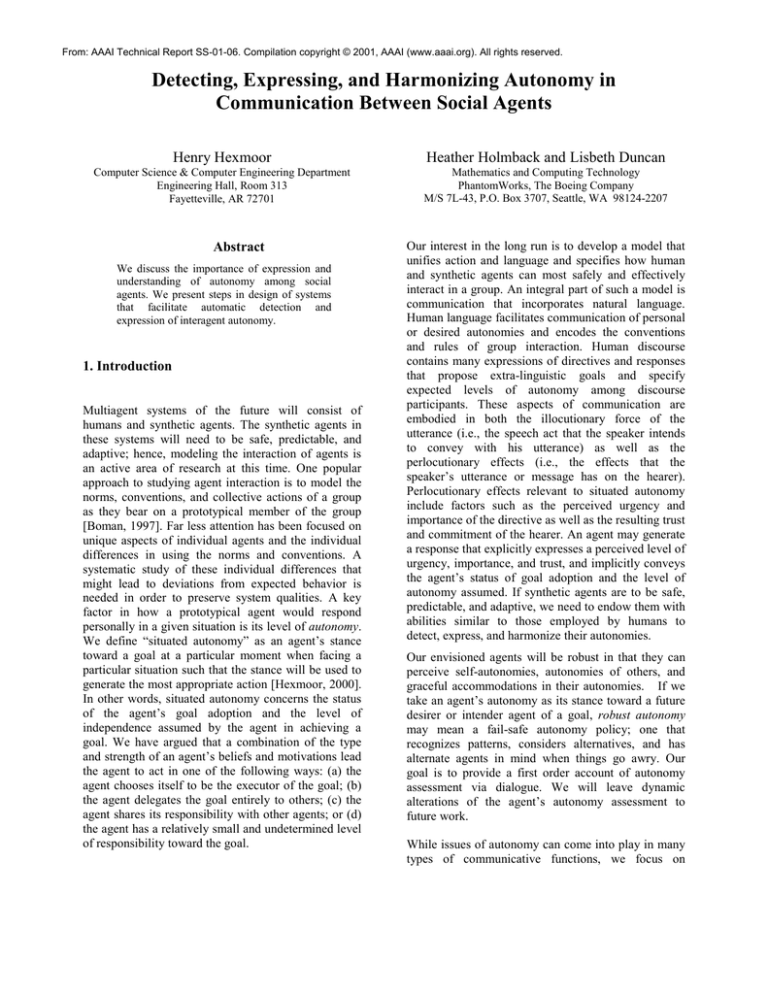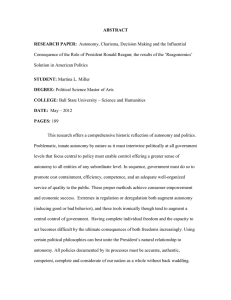
From: AAAI Technical Report SS-01-06. Compilation copyright © 2001, AAAI (www.aaai.org). All rights reserved.
Detecting, Expressing, and Harmonizing Autonomy in
Communication Between Social Agents
Henry Hexmoor
Heather Holmback and Lisbeth Duncan
Computer Science & Computer Engineering Department
Engineering Hall, Room 313
Fayetteville, AR 72701
Mathematics and Computing Technology
PhantomWorks, The Boeing Company
M/S 7L-43, P.O. Box 3707, Seattle, WA 98124-2207
Abstract
We discuss the importance of expression and
understanding of autonomy among social
agents. We present steps in design of systems
that facilitate automatic detection and
expression of interagent autonomy.
1. Introduction
Multiagent systems of the future will consist of
humans and synthetic agents. The synthetic agents in
these systems will need to be safe, predictable, and
adaptive; hence, modeling the interaction of agents is
an active area of research at this time. One popular
approach to studying agent interaction is to model the
norms, conventions, and collective actions of a group
as they bear on a prototypical member of the group
[Boman, 1997]. Far less attention has been focused on
unique aspects of individual agents and the individual
differences in using the norms and conventions. A
systematic study of these individual differences that
might lead to deviations from expected behavior is
needed in order to preserve system qualities. A key
factor in how a prototypical agent would respond
personally in a given situation is its level of autonomy.
We define “situated autonomy” as an agent’s stance
toward a goal at a particular moment when facing a
particular situation such that the stance will be used to
generate the most appropriate action [Hexmoor, 2000].
In other words, situated autonomy concerns the status
of the agent’s goal adoption and the level of
independence assumed by the agent in achieving a
goal. We have argued that a combination of the type
and strength of an agent’s beliefs and motivations lead
the agent to act in one of the following ways: (a) the
agent chooses itself to be the executor of the goal; (b)
the agent delegates the goal entirely to others; (c) the
agent shares its responsibility with other agents; or (d)
the agent has a relatively small and undetermined level
of responsibility toward the goal.
Our interest in the long run is to develop a model that
unifies action and language and specifies how human
and synthetic agents can most safely and effectively
interact in a group. An integral part of such a model is
communication that incorporates natural language.
Human language facilitates communication of personal
or desired autonomies and encodes the conventions
and rules of group interaction. Human discourse
contains many expressions of directives and responses
that propose extra-linguistic goals and specify
expected levels of autonomy among discourse
participants. These aspects of communication are
embodied in both the illocutionary force of the
utterance (i.e., the speech act that the speaker intends
to convey with his utterance) as well as the
perlocutionary effects (i.e., the effects that the
speaker’s utterance or message has on the hearer).
Perlocutionary effects relevant to situated autonomy
include factors such as the perceived urgency and
importance of the directive as well as the resulting trust
and commitment of the hearer. An agent may generate
a response that explicitly expresses a perceived level of
urgency, importance, and trust, and implicitly conveys
the agent’s status of goal adoption and the level of
autonomy assumed. If synthetic agents are to be safe,
predictable, and adaptive, we need to endow them with
abilities similar to those employed by humans to
detect, express, and harmonize their autonomies.
Our envisioned agents will be robust in that they can
perceive self-autonomies, autonomies of others, and
graceful accommodations in their autonomies. If we
take an agent’s autonomy as its stance toward a future
desirer or intender agent of a goal, robust autonomy
may mean a fail-safe autonomy policy; one that
recognizes patterns, considers alternatives, and has
alternate agents in mind when things go awry. Our
goal is to provide a first order account of autonomy
assessment via dialogue. We will leave dynamic
alterations of the agent’s autonomy assessment to
future work.
While issues of autonomy can come into play in many
types of communicative functions, we focus on
communication between human and synthetic agents
involving directives (i.e. commands and requests) and
responses to those directives. Responses can include
acknowledgment, acceptance, refusal, clarification,
and negotiation of the directive. Our goal is to develop
a framework and system in which synthetic agents can:
1) detect the appropriate illocutionary force and
perlocutionary effects in human communication in
order to operate with the appropriate level of situated
autonomy; 2) express relevant factors about their
autonomy and commitment in their communications
with humans; and 3) use spoken communication
appropriately to harmonize their autonomy with the
needs and constraints of the situation.
2. Our Approach
We make four observations here that characterize our
approach. First, detection and expression of implicit
autonomies requires a shared understanding of the
social roles and personal relationships of the
participating agents. For example, a complete stranger
usually will not issue a directive to another agent.
Furthermore, how seriously a directive is taken by one
agent depends on its perception of the authority of the
agent issuing the directive. Of course, the social
relationship between agents is not static; the changing,
or dynamic, relationship during the conversation
affects the harmony of autonomies. If two agents have
a positive relationship, each agent will change its
autonomy to complement the other agent.
“The third wheel” and many other proverbial
references point out the need for harmony in autonomy
of agents. In collaborative tasks, agents need to
compliment one another’s autonomy in order to
minimize redundancies and crossing paths. The point
of stating intentions before carrying out tasks is in-situ
coordination. Stating impending or possible desire or
intention is an approach to coordinate autonomies. “I
might consider doing X”, “I will make sure X”, “I
could do X” are examples.
Second, the form of the directive holds clues for
autonomy. One aspect of form is specificity. A very
detailed directive already contains many of the needed
decisions about the execution of the goal and leaves
little flexibility; that is, it expects little autonomy on
the part of the addressee. An indirect command (e.g.
“Could you do X?”) generally gives more autonomy to
the addressee than a direct command (e.g. “Do X.”).
Likewise, the form of the response to a directive also
conveys much information about the autonomy of the
speaker. For example, if an agent responds to a
directive by acknowledging it but not immediately
agreeing to it, this indicates that he assigns it a low
level of urgency relative to his current situation.
To be more precise, let’s consider an agent’s autonomy
can self-directed (Ii), other directed as in delegation
(Dij), shared with other agents as in teaming (Sij), or
be partially self-directed (Pi) [Hexmoor, 2000]. With
only two agents and 4 autonomy types, there are 24 =
16 cases. With more than two agents, there are many
more cases. Interesting cases are the ones where a
group agents have mutual shared autonomy that lead to
team formation.
Third, the content of a directive and the responses to it
contribute to the autonomy. There can be explicit
semantic content (e.g. “Do X now.” vs. “Do X when
you have a chance.”) that spells out the degree of
autonomy the speaker is giving the addressee with
respect to carrying out the directive. The content can
also be less explicit and more dependent on pragmatic
factors. For example, the amount of autonomy
allowed by “Do X soon.” is highly dependent on the
context in which it is uttered (e.g. the current tasks of
the addressee, the shared information about the nature
of X, the time constraints in doing X, etc.).
For simplicity, let’s consider only two agents I and j.
In the cases (Ii, Ij), (Pi, Pj), (Sij, Sji), autonomies are
harmonious. In the cases (Dij, Dji), (Dij, Sji),
autonomies are in clear conflict. In the cases (Ii, Sji),
(Pi, Sji), (Ii, Dji), (Pi, Dji), if we consider delegation or
sharing autonomies to preceded before the second
agent’s autonomy determination, there is no
disharmony. Otherwise, the agents have a disharmony
in their autonomy. Disharmony can be resolved by
dialogue as in utility-based negotiation.
Fourth, an agent’s internal mechanism for autonomy
determination affects the detection, expression, and
harmony of autonomies. In other words, the
communication between agents is not free from
individual biases. Characteristics of individual agents
are part of the situational context in which the
communication is interpreted.
There are many
endogenous sources of autonomy. For example,
transitory moods, drives, and overall temperament are
sources of autonomy for humans. For instance, the
hunger drive may lead to a distressed mood, and in this
In the remainder of this paper we will outline some
salient principle, sketch an outline of a methodology,
and give status of our implementations.
2
Communication Language (ACL). We will use the
same type of policies as a structure for human-agent
communication in our proposed work, but the policies
will govern natural language expressions. The
conversation policies needed for human-agent
communication will be embellishments and extensions
of those governing the communication between simple
synthetic agents, but will be similar to conversation
policies needed for more intelligent, more autonomous
agents. Our approach captures the similarities between
agent-agent and human-agent communication, while
allowing for differences in the actual expression of the
input and output of the agent system (i.e., an ACL or
natural language).
situation, an agent with an aggressive temperament
will tend to adopt a high level of self-autonomy to seek
food. Similarly for synthetic agents, there are possible
endogenous sources of autonomy, such as the need to
replace a battery or other energy source before being
able to continue any further interaction with other
agents. In such situations, agents will be unlikely to
harmonize their autonomy with others.
In sum, the form, content, and the pragmatics of
communication (i.e., the interpretation of the form and
content of an utterance relative to information in the
static and dynamic context) all contribute to situated
autonomy. A synthetic agent will need to analyze and
interpret a human agent’s linguistic input relative to
the context in order to detect information relevant to
forming its stance toward the goal. Likewise, a
synthetic agent will have to use the appropriate
linguistic form and content relative to the context to
generate a response to the human that communicates
its stance toward the goal.
While some aspects of situated autonomy will be the
same in agent-agent and agent-human interaction, in
the latter case the detection, expression, and
harmonization of situated autonomy involves the
interpretation and generation of natural language
utterances relative to the context provided by a set of
appropriate conversation policies governing the
human-agent interaction. To address this, as part of
this contract, we will extend our work in the following
areas: identifying the important elements of situated
autonomy; developing more complex conversation
policies for human-agent communication; and
expanding our natural language understanding and
generation
capabilities
to
facility
spoken
communication between agents.
In our approach, human-agent communication has
many similarities to human-human communication.
This is natural since in human-agent communication
there is a human in the loop using natural language
along with many of its implicit assumptions. However,
human-agent communication differs from humanhuman communication and is more similar to agentagent communication in the following ways: 1) there
are more limited topics and communicative functions
involved; 2) there is a lack of digressions; and (3) there
is a greatly reduced emphasis on politeness for social
needs. We plan to use our work on natural language
understanding and generation [Duncan, et al., 1999] as
well as our framework of conversation policies that
govern agent-agent communication [Greaves, et al.,
1999].
3. Sketch of an Autonomy Assessment Theory
via Dialogue
Here, we outline a methodology for detecting
autonomies in the agent’s top level loop.
A conversation policy is a model of the structure and
content of a type of agent conversation for a certain
communicative function. Conversation policies can
combine to form larger policies and can have varying
degrees of specificity. An instantiated conversation
policy includes information about the context in which
the communication is situated (e.g. timing constraints,
roles and relationships of the conversational
participants, reliability of the communication channel).
A set of conversation policies for the function of one
agent attempting to get another to carry out a certain
task would specify the timing and sequencing of the
directives and responses as well as any required
negotiation, repair of miscommunication, reporting of
the results of carrying out the task, beginning and
ending of the conversation, etc. In agent-agent
communication, these policies are intended to govern
the transmission of messages in some Agent
1. Upon receipt of a new command, use NL techniques
for initial assessment of desired autonomy at the
lowest confidence level.
2. If no feedback is received in a reasonable amount of
time, increase confidence.
3. If feedback is received in a short amount of time,
update desired autonomy using NL techniques.
4. If feedback is ambiguous, interrogate and update
autonomy:
4.1 Ask about expected intentions and desires
4.2 If 4.1 is ambiguous, ask about abilities of
commanding agent and its expected abilities from it.
3
4. Outline of Two Experimental Setups
5. Conclusion
In summary, our work on how synthetic agents detect,
express and harmonize levels of autonomy will affect
the theory of interoperability of intelligent,
autonomous agents. Our work contributes to an
understanding of how agent reasoning and
communication can be made safe, predictable, and
adaptive. We hope to extend our work in order to
contribute to the general theory of pragmatics in
communication involving humans and synthetic
agents.
We are developing the following two programming
environments for gathering data and conducting
experimenting. The first program gathers human
responses from suggestions made by a software agent
while playing a game that requires the human subject
to move a graphic object from one point to another
based on verbal interactions with the software agent.
This program involves a navigation task in which a
human player uses a joystick to navigate a submarine
in a minefield. The player’s objective is to move the
submarine from one point to another without hitting
any mines. The submarine has movement delays and
there is a time limit for moving from one point to
another. The software agent has more knowledge of
the domain and offers suggestions. The majority of its
suggestions are helpful; however, some of its
suggestions are not useful or will produce adverse
results. The human player does not initially know the
relationship between himself and the software agent
and the relationship changes over time. We gather
online feedback from the human player. We have not
finished implementation of this system but it appears
that people’s personal biases toward the agent
suggestion are difficult to factor out of the humanmachine interaction.
References
M. Boman (1997). Norms as Constraints on Real-Time
Autonomous Agent Actions. In M. Boman and van de
Velde (eds.), Multi-agent Rationality, Proceedings of
the 8th European Workshop on Modeling Autonomous
Agents in a Multi-agent World, MAAMAW’97,
Lecture Notes in AI, vol. 1237, Springer Verlag,
Berlin, pp. 36-44.
L. Duncan, W. Brown, C. Esposito, H. Holmback, P.
Xue (1999). Enhancing Virtual Maintenance
Environments with Speech Understanding. In The
Boeing TechNet, March 1999.
M. Greaves, H. Holmback, and J. Bradshaw, (1999).
What is Conversation Policy? In Proceedings of the
Autonomous Agents ’99 Workshop on Specifying and
Implementing Conversation Policies, Seattle, WA,
May 1999.
The second program aims at how a software agent can
detect, express, and harmonize its autonomy in
conjunction with a human operator. Our experimental
design involves a mobile robot that uses sonar and
limited visual abilities to map an unfamiliar area that
contains randomly located pieces of furniture. The
robot interacts with a human agent using natural
language understanding and generation in order to
achieve or to modify its objectives in accordance with
the changing dynamic context of the situation. The
majority of the human’s instructions are helpful, but
some might have adverse effects on the robot’s ability
to complete its mapping task. The human can make 3
movement requests: turn right/left/back; change
mapping grid-size. Human request for these commands
come in 5 shades of soft request to hard request. Hard
requests should be processed immediately. This is
giving the robot very little autonomy. Whereas soft
requests are to be processed after considering whether
they improve the mapping task. This is giving the
robot more autonomy. The robot does not have access
to the hardness of the request (i.e., desired autonomy
of the human operator) and guesses at it. By observing
the pattern of subsequent commands, the robot
modifies its guess at hardness of the request.
H. Hexmoor, (2000). A Cognitive Model of Situated
Autonomy, In Proceedings of PRICAI-2000 Workshop
on Teams with Adjustable Autonomy, Australia.
4





